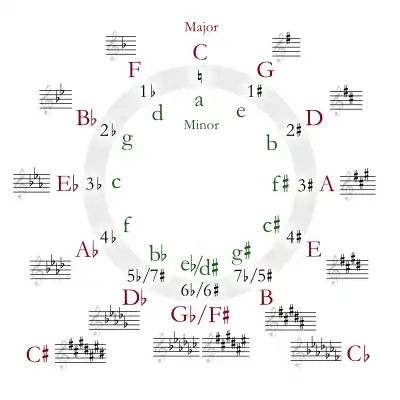A-sharp minor
A-sharp minor is a minor musical scale based on A♯, consisting of the pitches A♯, B♯, C♯, D♯, E♯, F♯, and G♯. Its key signature has seven sharps.
| Relative key | C-sharp major |
|---|---|
| Parallel key | A-sharp major (theoretical) →enharmonic: B-flat major |
| Dominant key | E-sharp minor (theoretical) →enharmonic: F minor |
| Subdominant | D-sharp minor |
| Enharmonic | B-flat minor |
| Component pitches | |
| A♯, B♯, C♯, D♯, E♯, F♯, G♯ | |
Its relative major is C-sharp major (or enharmonically D-flat major). Its parallel major, A-sharp major, is usually replaced by B-flat major, since A-sharp major's three double-sharps make it impractical to use. The direct enharmonic equivalent of A-sharp minor is B-flat minor, which only contains five flats and is often preferable to use.
The A-sharp natural minor scale is:
Changes needed for the melodic and harmonic versions of the scale are written in with accidentals as necessary. The A-sharp harmonic minor and melodic minor scales are:
In Christian Heinrich Rinck's 30 Preludes and Exercises in all major and minor keys, Op. 67, the 16th Prelude and Exercise is in A-sharp minor. In Bach's Prelude and Fugue in C-sharp major, BWV 848, a brief section near the beginning of the piece modulates to A-sharp minor.
Scale Degree Chords
- Tonic - A-sharp minor
- Supertonic - B-sharp diminished
- Mediant - C-sharp major
- Subdominant - D-sharp minor
- Dominant - E-sharp minor
- Submediant - F-sharp major
- Subtonic - G-sharp major




